Laptop Mag Verdict
The OnePlus 8T is a beautifully designed powerhouse of a smartphone, but it's cameras just can’t compete.
Pros
- +
Beautiful 120Hz display
- +
Strong performance
- +
Reliable software updates
- +
Excellent battery life for a 5G phone
- +
Unbelievable charging speeds
Cons
- -
Lacks wireless charging
- -
Average cameras
Why you can trust Laptop Mag
Price: $749
OS: Android 11 with OxygenOS 11
Display: 6.55-inch AMOLED (2,400x1,080)
CPU: Qualcomm Snapdragon 865
RAM: 12GB
Rear cameras: 48MP wide (ƒ/1.7); 16MP ultrawide (ƒ/2.2); 5MP macro; 2MP monochrome
Front camera: 16MP (f/2.4)
Storage: 256GB
Battery: 9:58 (120Hz); 10:49 (60Hz)
Size: 6.32 x 2.91 x 0.33 inches
Weight: 6.6 ounces
The OnePlus 8T follows the pattern of the “T” launches from OnePlus in years past, but the $749 device is in a more crowded market segment this year with competition coming from Apple, Samsung and Google.
That makes things a bit more challenging for the OnePlus 8T as it must do more to stand out from the crowd, particularly given that it comes in $50 higher than many of its competitors and lacks the brand cachet.
The OnePlus 8T actually looks the part of a flagship more so than anything else in this price range outside of the iPhone 12, and it matches up well when it comes to its display and performance. Its fast charging is untouchable by anything else on the market, but of course, it's not all roses.
The cameras are by far my biggest complaint with the OnePlus 8T, so if you rely on your smartphone as your main or only camera, take a careful look at the below samples. However, as you will see, the OnePlus 8T is a remarkable package outside of that one, admittedly crucial, area.
OnePlus 8T price and configurations
The OnePlus 8T has a single configuration that costs $749 and includes 256GB of storage, 12GB of RAM and a Qualcomm Snapdragon 865 processor.
I reviewed the Lunar Silver model, but the phone is also available in Aquamarine Green.
OnePlus 8T design
The OnePlus 8T doesn’t stray from the design OnePlus has been using for some years now. Best of all, it offers a premium fit-and-finish considering its more affordable $749 price. The metallic sides and matte-frosted glass back are surprisingly resistant to fingerprints and look the part of a flagship smartphone more so than the plastic back of the Galaxy S20 FE.
Sign up to receive The Snapshot, a free special dispatch from Laptop Mag, in your inbox.
The biggest change to the front of the OnePlus 8T versus the OnePlus 8 Pro is the switch to a flat display rather than the curved-edge waterfall display. The latter is certainly more associated with premium smartphones in the Android world ( see the Galaxy Note 20 Ultra). I'm not put off by the flat display look and often find it more usable. The front-facing camera remains a left-aligned hole-punch in the top of the display.
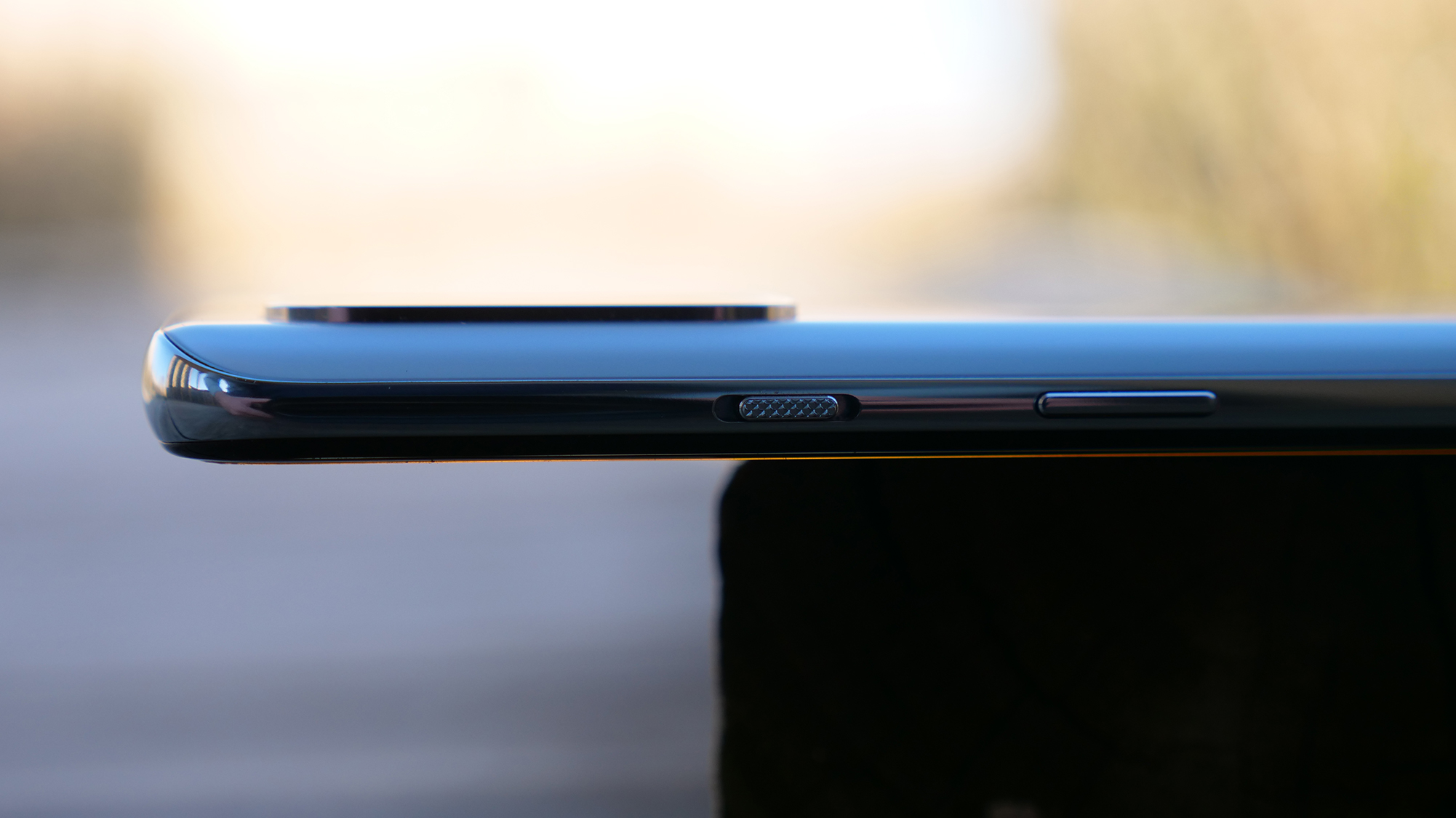
Along the left of the OnePlus 8T, are volume up and down buttons. And along the right is a multi-function button along with a unique audio toggle that lets you switch between silent, vibrate and ring modes. On the bottom, you have the standard USB Type-C port.
While the OnePlus 8T lacks the IP68 water and dust resistance of many of its competitors, it continues a common theme for OnePlus of not paying for the certification. The OnePlus 8T is properly sealed to protect it against water and dust ingress, so it shouldn’t be a problem if it takes a spill or a quick dip.
Turning to the back of the OnePlus 8T, you have the biggest departure from the OnePlus 8 Pro design with the new camera array. The central elongated oval or “pill” design is now gone in favor of the more common rounded rectangle in the upper-left corner of the OnePlus 8T.
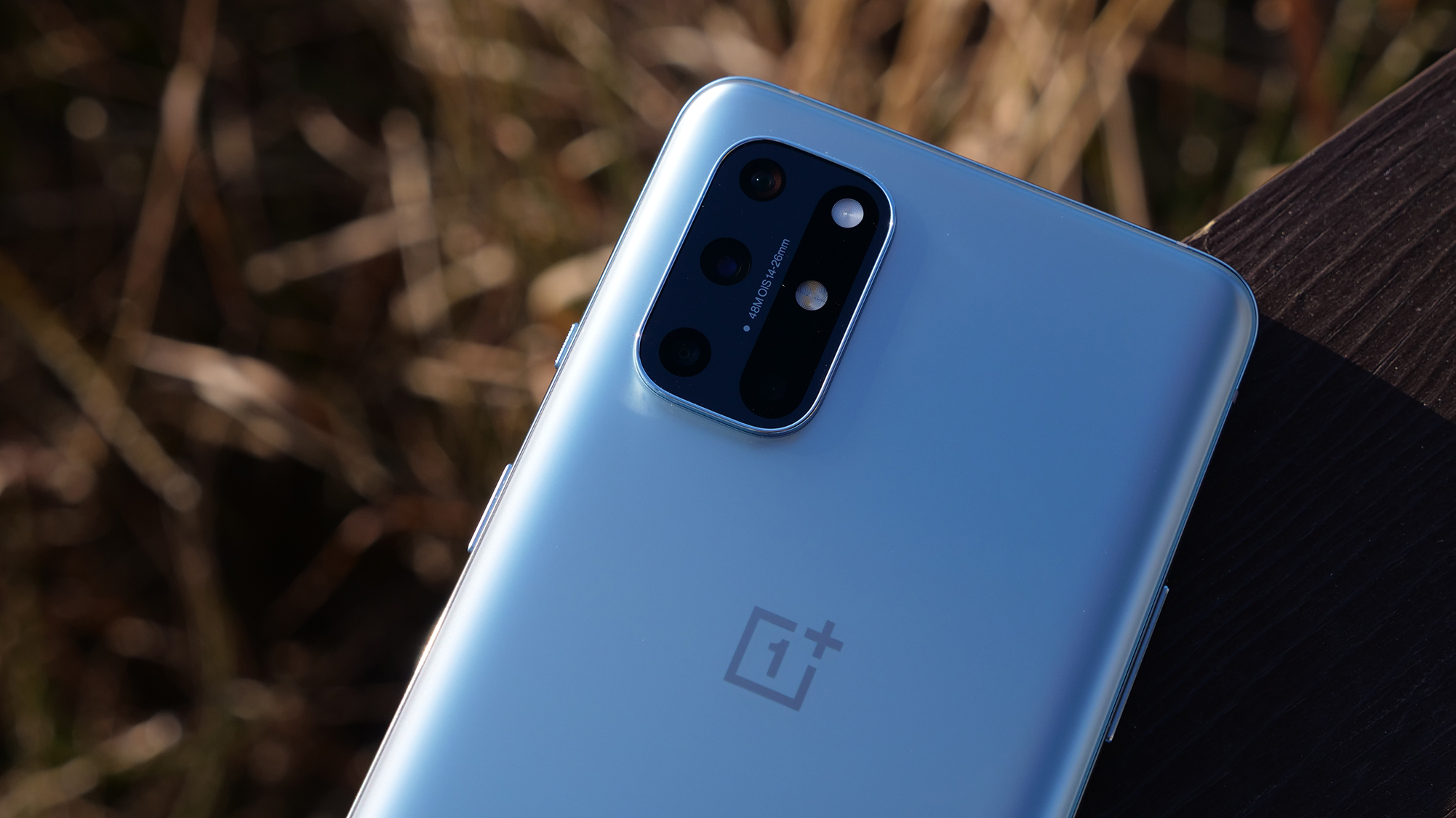
The OnePlus 8T measures 6.3 x 2.9 x 0.33 inches and weighs 6.6 ounces. This is nearly identical to the Samsung Galaxy S20 FE (6.3 x 2.9 x 0.3 inches) which also features a 6.5-inch display but is quite a bit taller than the smaller-screened iPhone 12 (5.8 x 2.8 x 0.29 inches) and the Pixel 5 (5.7 x 2.8 x 0.3 inches).
The most notable thing about the OnePlus 8T design is unquestionably the premium look the company has pulled off at this price point. While there’s little unique about the design (although I’ve always appreciated the physical ringer switch) it’s just a well-executed chassis.
OnePlus 8T display
The OnePlus 8T’s 6.6-inch AMOLED screen is stunning, delivering a bright image capable of deep contrast and a smooth 120Hz refresh rate.
I’ll be the first to admit that, prior to using a 120Hz display smartphone, I wasn’t sure how big of a deal it was, but going back to 60Hz now is difficult. Whether swiping around the operating system or within the increasing number of apps and games that support the faster refresh rate, everything looks and feels so much more responsive, delivering a legitimately transformative user experience.
With its large 6.6-inch OLED display and support for HDR10 content viewing, content on the OnePlus 8T is fantastic. I loaded up the first episode of Our Planet on Netflix, which is available in HDR10, and watched the section on orchids. The bright pearlescent green of the orchid bees jumps off the screen while it retains the subtle red and white shades of the orchid itself and the minute details like the fuzz on the bee.
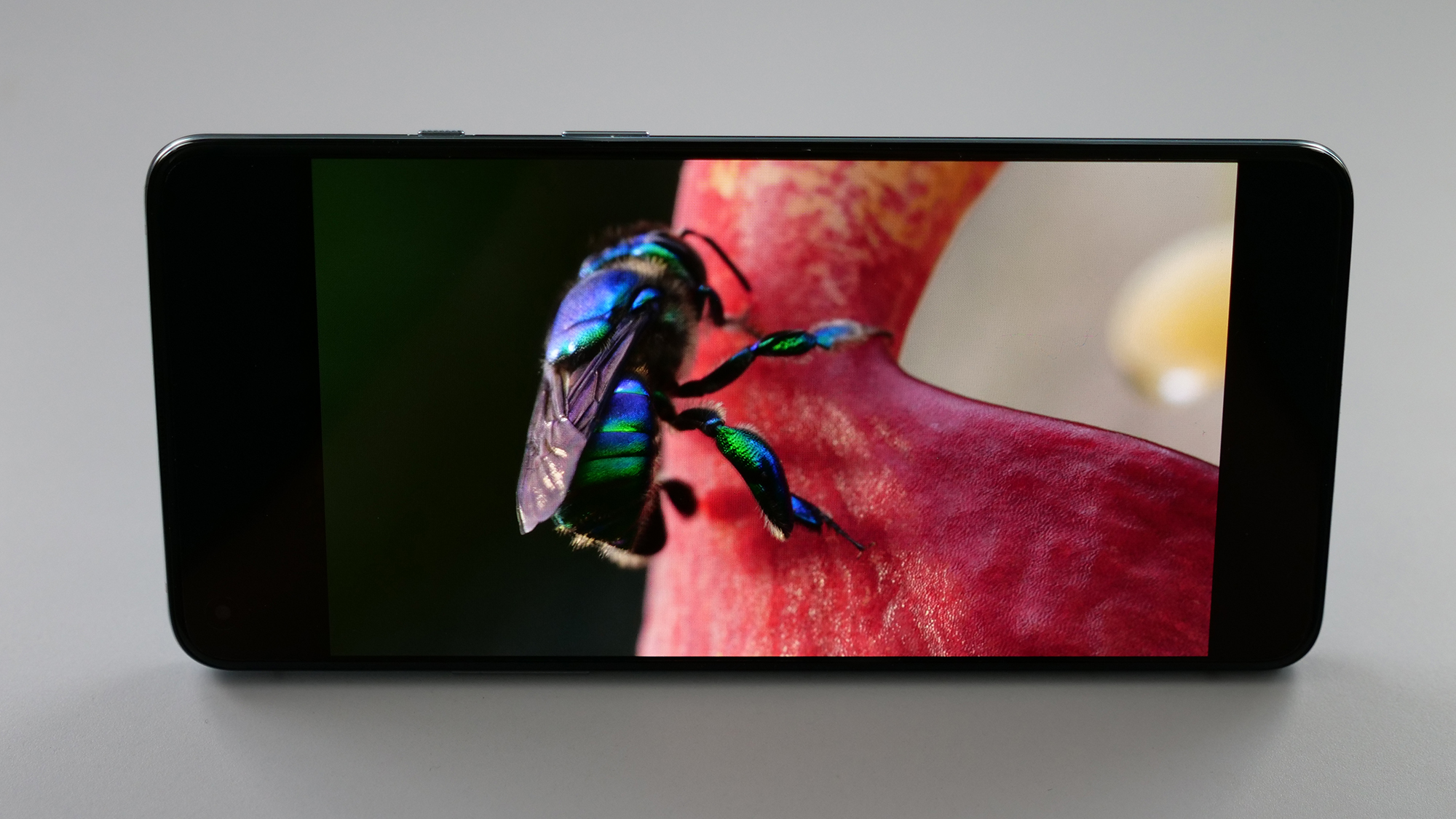
With its vivid settings turned on, the OnePlus 8T manages to reproduce a solid 120.2% of the DCI-P3 color space. That’s somewhat behind the Android competition like the Galaxy S20 FE (133.3%) and the Pixel 5 (128.8%), but well beyond the 82.2% of the iPhone 12. Switching the display settings to more natural colors drops you to 76.2% coverage.
The results of the Delta-E color accuracy test (lower is better) were roughly even across its competition. With the OnePlus 8T at its vivid setting, it achieved a 0.29, matching the iPhone 12 (0.29), but pushing slightly ahead of both the Pixel 5 (0.3) and Galaxy S20 FE (0.3). If you are willing to sacrifice the more saturated look of vivid for the more muted natural setting, the OnePlus 8T rockets into the lead here with a 0.22.
Brightness is not a problem for the OnePlus 8T, which hit a peak of 678 nits of brightness. This was just a single point below the Galaxy S20 FE (679 nits) and a dead tie with the Pixel 5 (678 nits). The iPhone 12 was the dimmest in this category with 570 nits.
OnePlus 8T audio
The OnePlus 8T features dual stereo speakers and Dolby Atmos support, which deliver impressive volume and some content-based settings (but not a full equalizer). The bottom-firing speakers in the OnePlus 8T were sufficient to easily fill my medium-sized testing room, although I preferred to step it back slightly from full volume as it loses some fidelity at its loudest.
I listened to James Arthur’s “Train Wreck” and the OnePlus 8T’s stereo speakers did an excellent job reproducing the rich echoing vocals. The subtle instrumentation was crisp and clearly distinguished. As ever, there’s minimal bass available for music with a stronger beat. If that’s not going to cut it for you then consider a good pair of wireless headphones.

OnePlus 8T performance
The OnePlus 8T gets the nearly top-of-the-line Snapdragon 865 chip, bested only by the 865+ on the Android side. OnePlus isn’t messing around with the rest of the specs on the U.S. model either with 12GB of RAM and 256GB of storage, both being considerably more than what you'll find from the competition.
My attempts to slow down the OnePlus 8T with two dozen Google Chrome tabs, a handful of my 120Hz games, and my Netflix show playing in picture-in-picture, were all handled with ease. When it comes to performance, the OnePlus 8T definitely lives up to the company’s “Never Settle” motto.
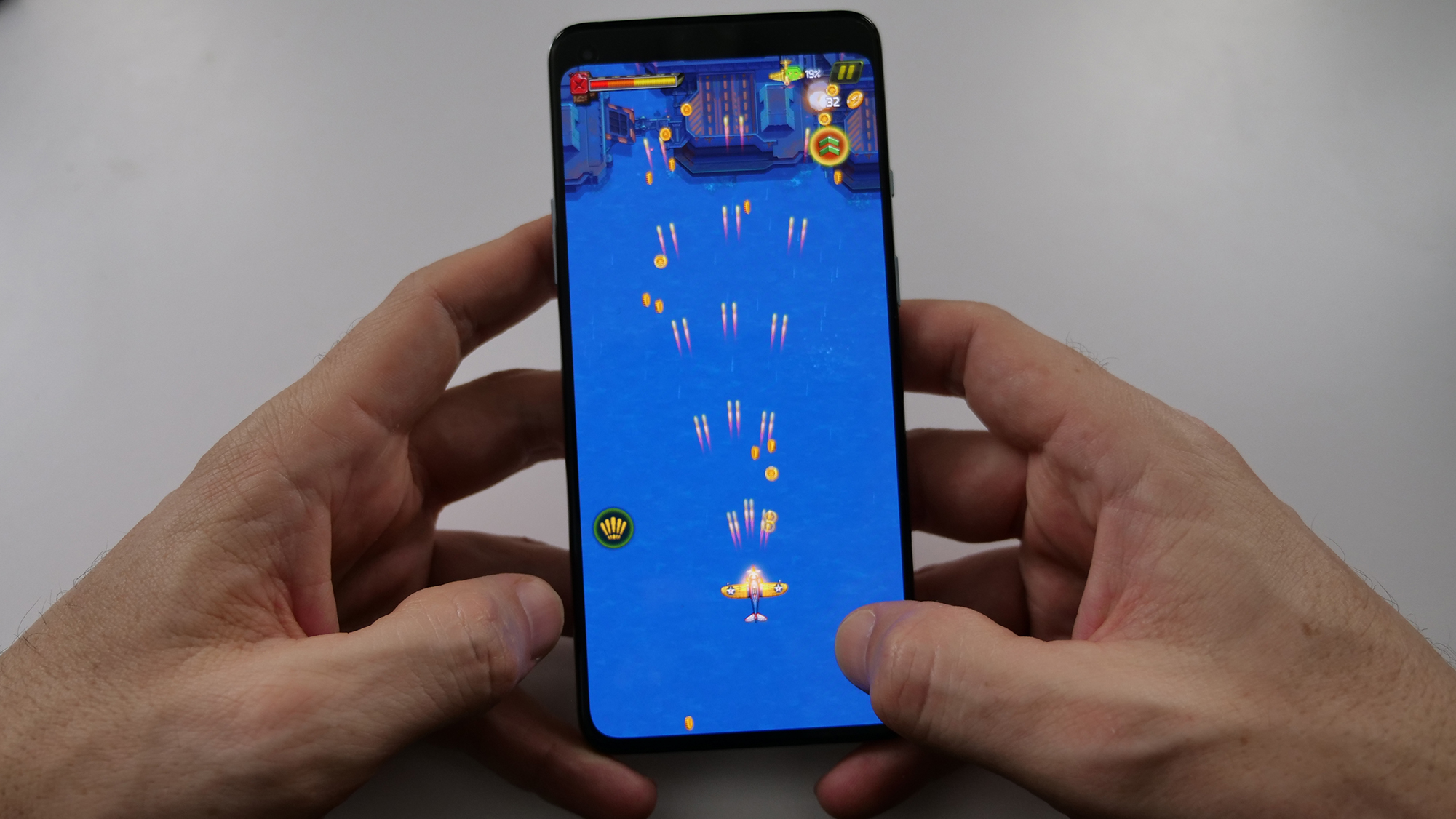
Taking a look at how it performed on our benchmarks, the 8T was largely the same, although it doesn’t hold a candle to the iPhone 12 and its A14 Bionic nor does any other Android phone). The OnePlus 8T got a 3,203 in the multi-core Geekbench 5 test. This put it behind the iPhone 12 (3,859, A14 Bionic), but quite a bit above the Samsung Galaxy S20 FE (2,928, Snapdragon 865) and light-years beyond the Pixel 5 (1,617, Snapdragon 765G).
GFXBench 5.0 is a more graphics-focused test and again, the OnePlus 8T managed a second-place finish at 1,375 frames (21 frames per second). The iPhone 12 (2,168, 34 fps) was first again with the Galaxy S20 FE (1,325, 21 fps) a close third with another distant last for the Pixel 5 (438, 7fps).
Our Adobe Premiere Rush video editing test is more of a real-world test and here, the OnePlus 8T slipped a bit, taking 1 minute and 38 seconds to transcode our 4K video to 1080p. The iPhone 12 (0:26) destroyed the rest in this one, while the Galaxy S20 FE (1:24) eked out second place and the Pixel 5 (2:25) was just happy to finish the task.
OnePlus 8T supports sub-6Ghz 5G, which was great for my testing on Ting, which uses T-Mobile’s 5G network, however it lacks support for mmWave so Verizon customers in a mmWave area won't get the full 5G experience.
OnePlus 8T battery life and charging
The battery life and charging situation with the OnePlus 8T is one of the most interesting aspects of the device, and I’m struggling to think of another time that I’ve said that about a smartphone.
This starts with the unique twin battery design that OnePlus is using on the 8T; the 4,500 mAh battery is in fact two 2,250 mAh batteries. This was done to allow for the tremendous 65W fast charging, which would otherwise be impossible with current technology. Best of all, OnePlus gives you that 65W charger in the box, a stark contrast to what we are seeing from Apple (and possibly Samsung soon) who takes even a basic charger away.
That 65W “Warp Charger” allows the OnePlus 8T to put up, far and away, the fastest charging results we’ve ever seen. Our standard tests look a bit silly with the OnePlus 8T as it managed a 55% charge in 15 minutes and 93% in 30 minutes. A full charge takes only 39 minutes, which again, given the 4,500 mAh of total battery in the OnePlus 8T, is mind-bending. By comparison, the Galaxy Note 20 Ultra, which includes a 4,500 mAh battery and a relatively fast 25W charger, will get you to 56% in 30 minutes.

Of course, that unbelievable charging wouldn’t seem as great if the battery life itself was weak, but the OnePlus 8T has some of the best runtimes we’ve seen on a 5G smartphone with a 120Hz display. In our test, which involves continuous web surfing at 150 nits of brightness, the OnePlus 8T lasted 9 hours and 58 minutes on its default 120Hz setting. This was enough to hold off the Pixel 5 (9:53) but it put the OnePlus well above the Galaxy S20 FE (8:58) and the iPhone 12 (8:25). If you choose to forgo the 120Hz and drop down to 60Hz, that runtime jumps up to 10 hours and 49 minutes.
I stuck with 120Hz throughout my time with the OnePlus 8T as it yields a much more pleasant user experience. My personal usage during the review included roughly an hour of Netflix and/or YouTube streaming, three to four hours of YouTube Music streaming, capturing photos and video, 30 minutes of gaming, and an hour of Slack, Twitter and general web usage. At no point did I end a day with less than 20% battery life remaining.

OnePlus 8T cameras
The OnePlus 8T features a quad-camera array on the back, but only three of those are really meaningful. The primary is a wide-angle 48MP with a solid ƒ/1.7 aperture, the secondary ultra-wide is 16MP at ƒ/2.2 and there is a 5MP macro. The fourth camera is a 2MP monochrome, but there’s little reason to use this over the primary lens with a black and white filter. Looking at the front-facing camera, it’s a 16MP at f/2.4.
The OnePlus 8T received an update on November 5, 2020 that included a number of camera improvements All of these images were captured following that update.
Wide-angle camera
The fast aperture and relatively high MP count on the primary wide-angle lens of the OnePlus 8T produced quite solid results for me in a variety of conditions. The level of detail and accuracy of the color captured in daylight is fantastic. This sunflower is beginning to succumb to the cold here and the OnePlus 8T captured the curling petals and the yellow pops against the cloudless sky.

This bush in my yard is, unfortunately, losing its color, but it still offers a brighter splash than the wide-angle lens of the OnePlus 8T. While Samsung has a tendency to oversaturate and Apple goes a bit too natural for my tastes, the OnePlus 8T just missed on this one, neither delivering a realistic or more pleasant (if less realistic) image.

While the OnePlus 8T doesn’t offer a telephoto lens with its 48MP primary sensor, it offers a fair amount of digital zoom. The full range is 0.6x from the ultra-wide all the way up to 10x using the primary sensor. Up to about 3-5x is reasonably usable, while 10x is useful only as a spotting scope. Here’s what that full range looks like.

OnePlus 8T Ultra-Wide - 0.6x

OnePlus 8T Wide-Angle - 1x

OnePlus 8T Wide-Angle - 5x

iPhone 12 Wide-Angle - 10x
Ultra-wide camera
The 123-degree ultra-wide-angle lens can bring in landscapes or capture group photos with ease. I often found myself preferring results from this lens with its more saturated look compared to those from the wide-angle. Here’s a look at that same bush in my yard and it’s virtually unrecognizable; this is much more accurate.

I had occasional focus issues when using the ultra-wide lens on the OnePlus 8T. I tried capturing this miniature scene my daughter made and was tapping to focus on the deer in this photo with no luck after multiple efforts.
Ultimately, I found the ultra-wide a bit frustrating as I appreciated its colors and the range for some circumstances, but it was less reliable than the primary when it came to getting the shot.

Macro camera
The vast majority of users prefer a telephoto lens, so this macro lens is a definite tell that this is a more affordable smartphone, but depending on the type of photos you like to take, it can be useful.
Photos with the macro lens require you to get within 1-2 inches of the object. That obviously limits its utility but here are some samples from the macro lens to give you an idea of what you can do with it.

OnePlus 8T macro camera samples

OnePlus 8T macro camera samples

OnePlus 8T macro camera samples
Front-facing camera
I was thoroughly impressed with the results from the front-facing camera on the OnePlus 8T. It offered solid colors and detail as opposed to the often over-smoothed results I saw with the much higher 32MP front-facing camera on the Samsung Galaxy S20 FE.
Just avoid the portrait mode; OnePlus definitely has some work to do on the computational photography side of things as it failed to accurately separate me from the background.

OnePlus 8T front-facing camera sample

OnePlus 8T front-facing camera sample - Portrait mode
Video
The OnePlus 8T offers a similar array of video options to most flagships with 4K at up to 60fps and 1080p at up to 240fps in Super Slow Motion mode. If you are really looking to slow things down, you can drop to 720p at up to 480fps.
For those looking to capture action shots with their smartphone, Super Stable mode will help you keep it watchable by applying both optical and electronic image stabilization. OnePlus has also added a number of video modes like Nightscape, Video portrait, CINE Aspect Ratio recording and Video Focus Tracking.
The standard video capture on the OnePlus 8T is fine, but it’s got a ways to go to actually compete with the Samsung Galaxy S20 FE or the iPhone 12.
OnePlus 8T software
The OnePlus 8T runs Android 11 with OxygenOS 11 on top of it, which is a relatively minimal skin. OnePlus has established an excellent reputation in recent years for delivering Android updates with nearly the same speed as Google, and its devices are typically in Android beta updates as well.
Android 11 isn’t a feature-packed update, but it comes with a number of conveniences, like floating chat bubbles for messaging apps, a new “one-time permission” option, media controls integrated into the notification shade, and built-in screen recording. OxygenOS 11 adds some additional niceties on top of that including a collection of Always-on display modes, enhanced Smart Gallery for photos, a new more readable system font and an overall look that bears a resemblance to Samsung’s OneUI.
While not everyone is thrilled with the shift away from the vanilla Android look, this is really more of a matter of personal preference and it isn’t a massive divergence, so it’s easy to adjust to for anyone switching from another Android device.
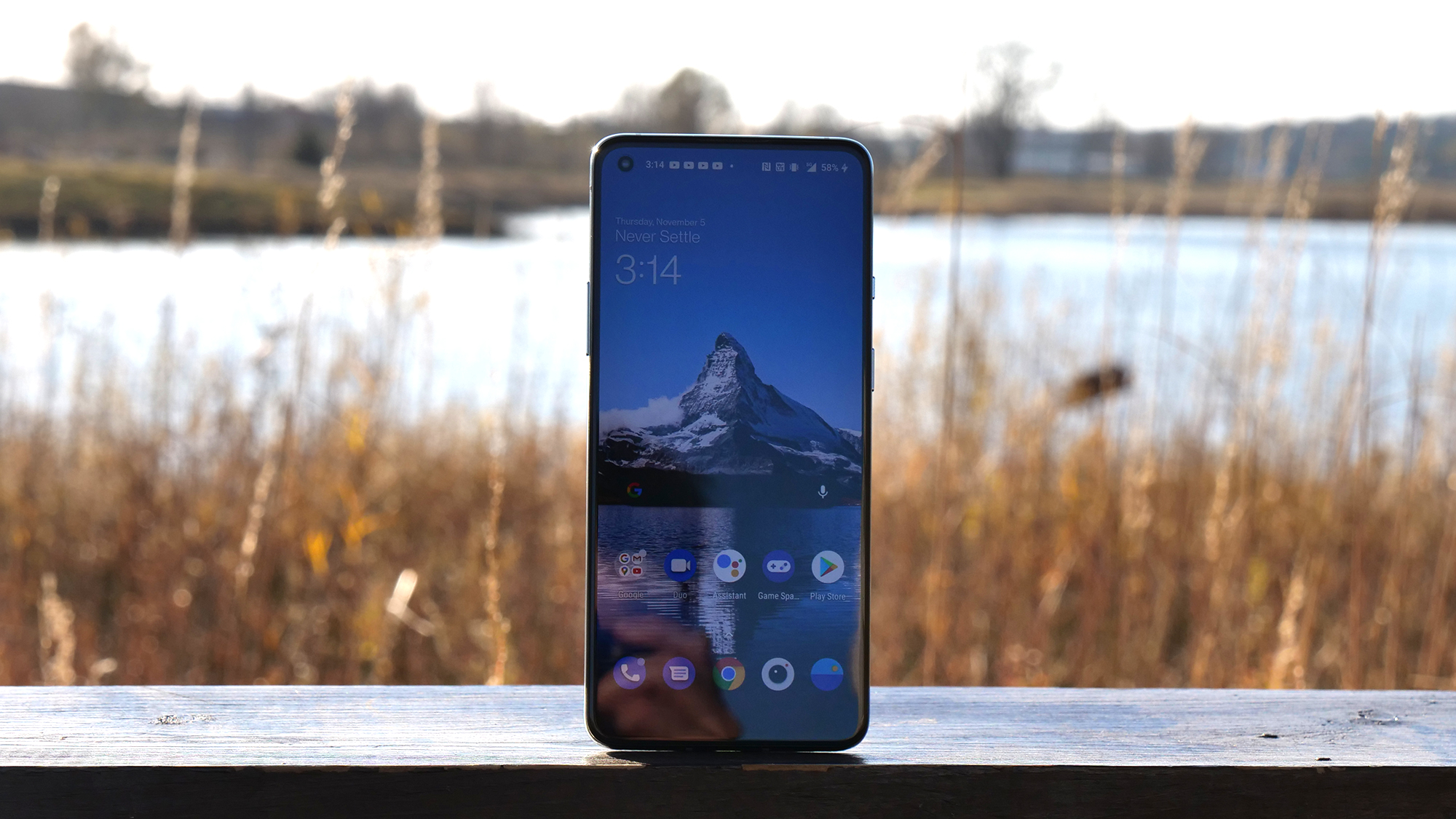
Bottom line
The OnePlus 8T gets so much right that it makes the few things it gets wrong all the more frustrating. The cameras proved too unreliable for me to want to use this device; it’s not that they can’t produce an excellent image at times, the cameras simply aren't consistent. As a parent that often only gets one chance at some photos, I find that experience too frustrating.
If mobile photography and videography aren’t your thing, the OnePlus 8T absolutely belongs on your shortlist of devices. At $749, it gives you 256GB of storage, which is double that of the Pixel 5 or Samsung Galaxy S20 FE and four times that of the base iPhone 12 and iPhone 12 mini. The performance and display are on par with the best of what Android has to offer and the phone looks and feels like a $1,000 flagship.
OnePlus has a history of updating its cameras and ultimately delivering solid results. The company has already issued one that improved things, so I’ll be keeping tabs on any enhancements going forward. For now, unless your smartphone camera is an afterthought, I’d recommend the Samsung Galaxy S20 FE, iPhone 12 or Pixel 5 if you are looking in this price range.
Sean Riley has been covering tech professionally for over a decade now. Most of that time was as a freelancer covering varied topics including phones, wearables, tablets, smart home devices, laptops, AR, VR, mobile payments, fintech, and more. Sean is the resident mobile expert at Laptop Mag, specializing in phones and wearables, you'll find plenty of news, reviews, how-to, and opinion pieces on these subjects from him here. But Laptop Mag has also proven a perfect fit for that broad range of interests with reviews and news on the latest laptops, VR games, and computer accessories along with coverage on everything from NFTs to cybersecurity and more.


